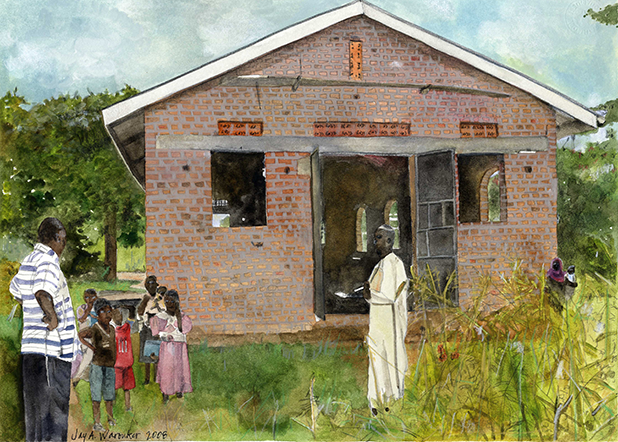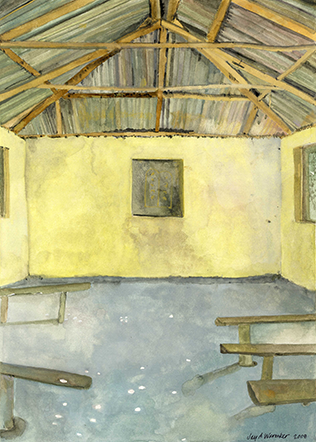 Exterior View (2008), 11” x 15” Watercolor, Jay A. Waronker
Exterior View (2008), 11” x 15” Watercolor, Jay A. Waronker
uganda
Synagogue (Original building from the early 1970s, Current Building dates to 1980) |
|

Interior View (2008), 11” x 15” Watercolor, Jay A. Waronker
|
Uganda is home to the Abayudaya (from the Lugandan word for “Jewish People” or “People of Judah”) community of Jews, a group made up of the large Bantu ethnic group native to Buganda, a subnational kingdom within the country. The black Abayudaya Jews live not at a single place in this region but in a string of unassuming and peaceful villages in the eastern part of Uganda not far from the Kenyan border. There a collection of modest synagogues building over fairly recent years can today be found. These Jewish houses of prayer are located to the east of Mbale, Uganda’s seventh largest city and the main municipal, administrative, and commercial center of Mbale District and the surrounding sub-region.
Christian and Muslim neighbors once looked on the Abayudaya with contempt, but inter-faith relations in recent times have improved, and some now view members of the Abayudaya with respect and admiration. Whereas the Abayudaya Jewish population was estimated at three hundred individuals at the time of the fall of Idi Amin in 1979, the community is said to now number up to two thousand people.
Besides the five synagogues located in the towns of Namutumba, Nasenyi, Putti, Namanyonyi, and Nabugoye, Abayudaya Jewish schools have been established in recent years with outside help from individuals and international Jewish organizations such as Kulanu. As the Abayudaya community has increased its interactions with outside Jews, mainly those from the United States and Israel, over the past dozen or so years, its religious ideology and customs has shifted towards more mainstream and normative Judaism. Members attend Shabbat services regularly following a conventional prayer book, maintain a kosher diet and slaughter their own animals in accordance with its regulations and, out of character from most Jews, remove their shoes before entering the synagogue in reverence to a practice by Jews in biblical times.
The village of Nasenyi, east of Mbale and reached by an easy drive, once had a small synagogue. The structure was destroyed by President’s Idi Amin’s forces in the early 1970s. Amin’s rule, categorized by human rights abuse, ethnic cleansing, and political and religious repression, prohibited the operation of synagogues. Shortly after the brutal Amin was deposed, a synagogue was allowed to be rebuilt in Namutumba. The house of prayer came to represent the rebirth and resurgence of Abayudaya’s Jews after years of hardship, oppression, and discrimination. In 1980, the year after the brutal Amin was deposed, a synagogue was rebuilt in Nasenyi. The synagogue came to represent the rebirth and resurgence of Abayudaya’s Jews after years of oppression and discrimination.
Nasenyi Synagogue is constructed out of locally-made rough bricks, a corrugated metal hipped roof set on hand-cut wood framing, and wood-framed openings without proper windows and doors. The simple building is built directly on the ground without any type of foundation, and it is surrounded by a dirt path and overgrown vegetation. Today the Jewish population of Nasenyi is quite small, but the community is active, devout, and growing.
The synagogue in Nasenyi, Uganda is a one-room space measuring approximately 12’ x 19’. It contains a dirt floor, hand-made brick and mud walls, and rough wood roof framing left exposed on the inside that is covered in corrugated metal sheets. The space is intimate: 8’ high walls sloping up to 11’ along the roof ridge, five wood-framed openings without proper windows and hence left open to the elements, and two openings without actual doors. The space is filled with flat wooden benches fixed to the floor and an Ark niche intended to house the Sefer Torah.
The walls of the Nasenyi Synagogue are bare, and there are no architectural or liturgical decorations or flourishes, whether typical to synagogues anywhere in the world or personalized to this congregation, anywhere in the space. The building has no electricity or other utility services. Despite its seemingly rudimentary appearance, one needs to remember that a synagogue is technically just a gathering interior or even exterior place (albeit with the Sefer Torah) for a minyan (quorum) to congregate for prayer services, and it does not by any means need to be a well-appointed and lavish space.
